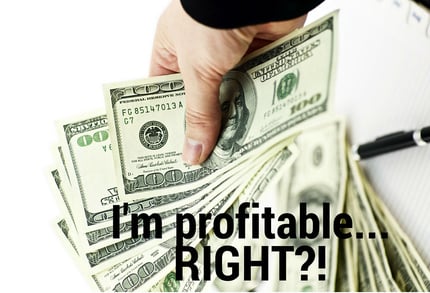Does Cash in the Bank Mean You're Turning a Profit?
Is your business profitable? If you’re pointing enthusiastically to the balance in your bank account, and nodding your head "Yes," you may be in for a big  surprise. The fact of the matter is that cash in your account doesn’t necessarily translate into profit in your pocket. Why? Because the money you have on hand today doesn’t always reflect the payments coming due tomorrow.
surprise. The fact of the matter is that cash in your account doesn’t necessarily translate into profit in your pocket. Why? Because the money you have on hand today doesn’t always reflect the payments coming due tomorrow.
Two Sides to Every Story
Like many things in life, there are two sides to every story when it comes to bookkeeping for your small business. There’s the side where cash flows into your account as income and the side where it flows back out again as expenses. Your profit is simply the difference between the two.
But because these two chapters of the cash flow story don’t always coincide, it can lead you to believe you’re earning a profit on the sale of your product or service, when in fact you may not be. Just as we use credit cards in our everyday lives to delay paying for certain personal expenses, many of the costs associated with running your small business get deferred in the same way.
The bottom line is that, without a proper bookkeeping system in place, you can’t possibly answer the question that’s on every business owner’s mind: Exactly how much money am I making?
It’s All about Timing
In the world of personal finance, if I use my credit card to purchase a big-screen TV for $500 on Monday, and then receive a paycheck for $2000 the following Friday, I can’t really say that the entire $2000 now sitting in my bank account belongs to me. The truth is that only $1500 of this amount is mine and $500 belongs to the store from which I just purchased my television. In other words, the cash in my bank account doesn’t truly represent the profit I earned from working all month until all of my bills for the same period of time have been paid. The same holds true for your business.
This is especially important to recognize if your business is part of an industry that receives payment from clients immediately upon delivering its goods or services. If you run a restaurant, for example, your customers are given a meal and then they pay for it right away. Restaurants don’t generally operate with an accounts receivable system whereby they feed their customers today, then bill them so they can collect payment for the meal next month. This means that, as a restaurant owner, you’re likely depositing money into your bank account every day. If your restaurant is very popular, this could lead you to believe that your business is booming and generating a huge profit.
But what about the other side of the cash flow story? How much do you still owe your suppliers for the food you’ve served, the utility company for the electricity powering your lights and appliances, the staff for making it all happen, and the insurance company for that big annual premium that’s due next week? Remember that the money flowing into your bank account is not all profit, and if it’s the only number you ever look at, you could be fooling yourself into thinking your business is yielding a certain level of income when it’s not.
Finding Your Profit
Proper bookkeeping that consistently tracks your business income and costs will help you avoid confusing the money in your bank account with profit. In fact, the very nature of bookkeeping ensures that one side of your business story will always be balanced effectively against the other side. Customer receipts and cash in the bank, for example, will always be measured off against current and pending expenses, such as payroll and taxes. The difference between the two sides is where your profit lives.
It’s only by recording and evaluating these fluctuating amounts each month that you’ll know for sure how much your business is really earning. Monitoring the financial performance of your business on a regular basis is vital. If you simply don’t have the time or the knowledge necessary to correctly measure that performance for yourself, do yourself a favor and hire someone who has both.
Photo Credit: Canva


Comments